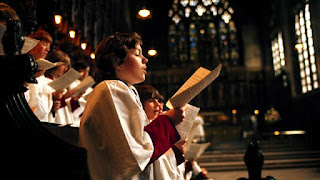 |
| Trinity College Dining Hall |
One of our serendipitous moments in Cambridge has been lunch at Trinity College with Rose Langley's cousin Michael and his wife Sue. Rose is a friend back at East Taieri Church. Her cousin is Sir Michael Berridge, a world renown physiologist and biochemist, fellow of Trinity College, knighted for services to science and a list of awards and honours as long as your arm. Sue was aware of his best known work on cellular transmembrane signalling, in particular the discovery that inositol trisphosphate acts as a second messenger, linking events at the plasma membrane with the release of calcium ions within the cell. Currently Michael's area of research is in neurological disorders such as Altzheimer's.
 |
| Statue of Thomas Babington Macaulay |
The setting was inspiring. The portraits around the dining room walls began with King Henry VIII, who founded the College in 1546, and continued with Fellows of the College. Fellows and alumni (members) include: Isaac Newton, James Maxwell, Francis Bacon, Lord Byron, Alfred Tennyson, J J Thompson, Ernest Rutherford, Niels Bohr, A A Milne, Sue Carr, Prime Ministers and members of the Royal Family. Research from this institution has impacted the world, particularly in mathematics and science, but also in law and literature and other disciplines. It has produced 33 Nobel Prize winners. Interestingly, it is only more recently that Trinity "Fellows" have included more women and non-europeans.
On the one hand, this was awe inspiring. Michael kindly helped us do the tourist thing taking our photograph with a statue of Sir Isaac Newton, and also with another alumni, the historian and politican Lord Macaulay outside Trinity Chapel.
One of the strengths (and complexities) of Cambridge University is the College structure. Colleges like Trinity gather great minds from around the world in many different disciplines so they can interact and learn from each other. This benefits both students and fellows. Many a research breakthrough has occurred through an oblique conversation with someone from another discipline or through building on prior research from the same college. How awe inspiring to be in a place that gathers great minds like this.
 |
| Wren Library, Trinity College |
However, on the other hand, this time inspired me that we can all contribute something to make a difference in the world. These were also ordinary people, in an actual place. They had to sit down and study, think and write and make it happen. In the Wren Library (designed by Sir Christopher Wren in 1676) we saw AA Milne's original handwritten notebook of Winnie the Pooh. He had to put the words on paper like any of us. "BANG!" in big letters in his notebook became "
BANG!" in the printed book. We clapped our hands in the cloister corridor where Isaac Newton clapped his hands to make and echo to calculate the speed of sound. Someone has to take these profound, yet often simple, steps. It may as well be us.
 |
| Trinity cloister where Newton calculated the speed of sound |
The people who made great discoveries, weren't usually famous before they made them! I have always told our children and our staff, if you are interested in something, find out the best people in the world who can tell you about it and ask if you can talk to them, or read their work.
Michael Berridge shared a research insight he had gained back in his post-doc days. A fellow researcher had advised him, "Don't be a fluff-wiper". We asked what that meant and Michael explained that in science (and I would say probably all disciplines) there are some big questions to be answered. But surrounding these big questions are hundreds of smaller, less consequential questions. Some scientists spend their careers working on the smaller fluff that surrounds the big questions. When they solve a smaller question, they wipe off that piece of fluff, but the big question remains unanswered. Michael realised that until then he had been a "fluff-wiper". He stopped work, reoriented his research and went on to make his huge discoveries in biochemistry.
I asked him if had any other advice for researchers. He replied, "Make sure you have a strong, clear working hypothesis." That provides a clear path for the research. Of course the hypothesis may turn out to be wrong, and so is discarded, but at least you have clearly eliminated one possibility.
Our son is getting into a PhD in ecology. While talking with him about this raised a third piece of advice. Don't fall down a wormhole! He had heard of someone who abandoned a PhD because they realised their work was so isolated and specialised it was dragging them away from research of any value. (Now, I'm sure some "wormholes" have led to valuable results, but the general point is made.)
In an effort to learn from these insights, I am seeking to clarify the big questions of my research into the way God uses the Bible to help us grow spiritually, and arrange my notes and thoughts in a strong clear direction that will be of benefit to people at East Taieri (and others) when we return.
God Bless you,
Martin
(Martin and Sue having dinner with our new friends from Michigan, at the table in the Cambridge pub called "The Eagle" where Francis Crick and James Watson dined each week and was where in 1953 they chose to announce they had discovered the structure of DNA)














































